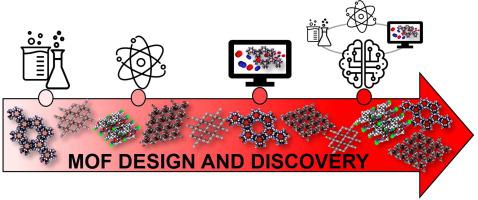Coordination Chemistry Reviews ( IF 20.3 ) Pub Date : 2023-03-21 , DOI: 10.1016/j.ccr.2023.215112 Hakan Demir , Hilal Daglar , Hasan Can Gulbalkan , Gokhan Onder Aksu , Seda Keskin

|
金属有机框架 (MOF) 的网状化学允许生成几乎无限数量的材料,其中一些可以替代传统上在各个领域使用的多孔材料,包括气体储存和分离、催化、药物储存和输送. MOF 的数量及其潜在应用增长如此之快,以至于在合成新型 MOF 时,测试它们的所有可能应用是不切实际的。基于材料分子模拟的高通量计算筛选方法已广泛用于研究 MOF 并确定特定应用的最佳 MOF。尽管计算资源不断增加,但考虑到巨大的 MOF 材料空间,有前途的 MOF 的计算识别需要在时间和精力方面更有效的方法。利用数据驱动的科学技术可以提供关键优势,例如通过建立机器学习 (ML) 模型和解释可以超越专家直觉的复杂结构-性能关系来加速 MOF 设计和发现途径。在这篇综述中,我们介绍了推动 MOF 计算建模的关键科学突破,并讨论了从分子模拟扩展到 ML 算法的最先进方法。最后,我们对大数据驱动的 MOF 设计和发现的未来潜在机遇和挑战提出了自己的看法。利用数据驱动的科学技术可以提供关键优势,例如通过建立机器学习 (ML) 模型和解释可以超越专家直觉的复杂结构-性能关系来加速 MOF 设计和发现途径。在这篇综述中,我们介绍了推动 MOF 计算建模的关键科学突破,并讨论了从分子模拟扩展到 ML 算法的最先进方法。最后,我们对大数据驱动的 MOF 设计和发现的未来潜在机遇和挑战提出了自己的看法。利用数据驱动的科学技术可以提供关键优势,例如通过建立机器学习 (ML) 模型和解释可以超越专家直觉的复杂结构-性能关系来加速 MOF 设计和发现途径。在这篇综述中,我们介绍了推动 MOF 计算建模的关键科学突破,并讨论了从分子模拟扩展到 ML 算法的最先进方法。最后,我们对大数据驱动的 MOF 设计和发现的未来潜在机遇和挑战提出了自己的看法。我们介绍了推动 MOF 计算建模的关键科学突破,并讨论了从分子模拟扩展到 ML 算法的最先进方法。最后,我们对大数据驱动的 MOF 设计和发现的未来潜在机遇和挑战提出了自己的看法。我们介绍了推动 MOF 计算建模的关键科学突破,并讨论了从分子模拟扩展到 ML 算法的最先进方法。最后,我们对大数据驱动的 MOF 设计和发现的未来潜在机遇和挑战提出了自己的看法。

"点击查看英文标题和摘要"































 京公网安备 11010802027423号
京公网安备 11010802027423号